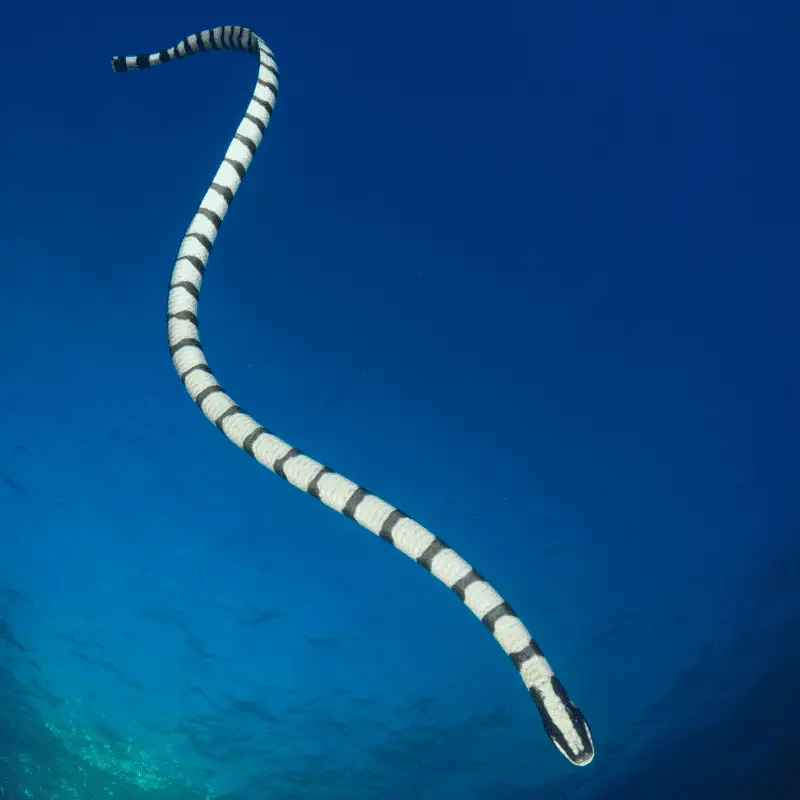The faint banded sea snake is also known as one of the most poisonous snakes across the world. Also known as Belcher’s sea snake, the faint banded snake got its name from its discoverer, the famous British naval officer Admiral Sir Edward Belcher. In 1849, Edward was the first person to identify and name the snake. Years after that, Charles Darwin found the snake. However, once he got to know about the discovery of Belcher, he removed his discovery claim.
Even though Belcher’s sea snake is highly venomous, it is shy. That means the snake suffers provocation and mistreatment before it bites anyone.
More often than not, the fishermen become the victim of a faint banded sea snake bite. As the snake rarely injects a substantial amount of venom, only a quarter of the bite victims get envenomated.
Species Overview
- Scientific Name: Hydrophis belcheri
- Family: elapid
- Lifespan: 4-5 years
- Length: up to 3 feet
Location
Most of the time, these snakes are found swimming in the tropical reefs of New Guinea, the Indian Ocean, the Gulf of Thailand, the Philippines, the Northern Territory of Australia, Solomon Islands, and Indonesia.
They are also quite common in the Ashmore reef in The North-Western part of Australia. These snakes are also quite prevalent in New Caledonia.
Description
The size of the adult snakes ranges from 0.5 meters to 1 meter. These snakes sport a Yellowish cream body with dark Green Cross bands. The ventral pattern and the dorsal pattern of the snake body are not the same.
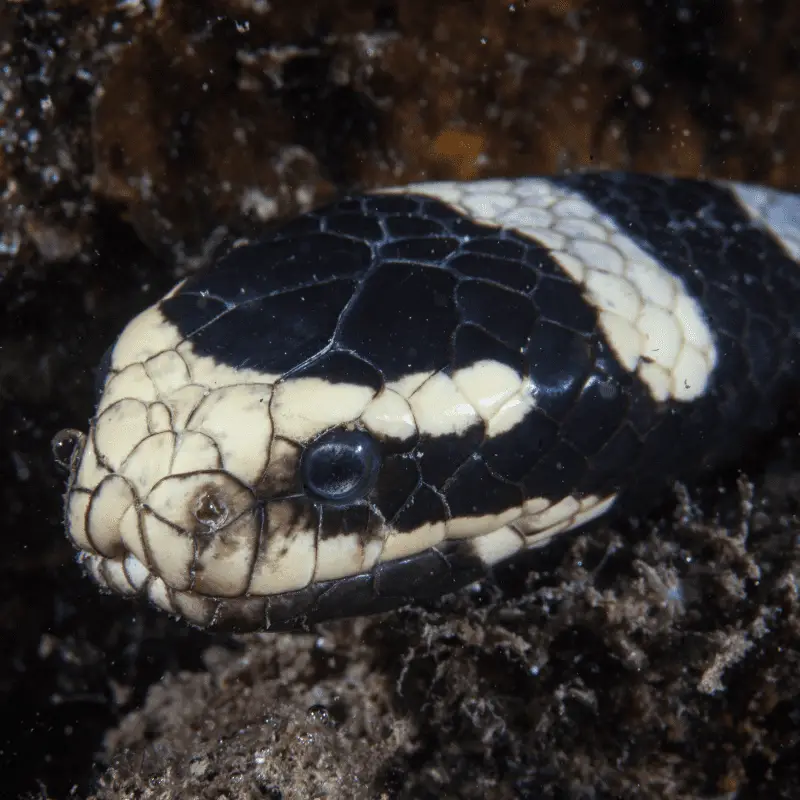
The head of the snake is small and short and showcases the same pattern. Compared to the mouth of the terrestrial snakes, the mouth of the faint banded sea snakes is relatively tiny and perfect for aquatic life. When in the water, these snakes appear to have a pale yellowish hue.
Scales
The scales of the snake are different from most other snakes; they overlap each other. Each of the dorsal scales comes with a central tubercle. Compared to other snake species, the ventral scales of these snakes are narrow.
These scales are only a bit wider than their dorsal scales. Even though they are aquatic, these snakes breathe through their nose. The nostrils of the faint banded sea snakes are situated on the top of its snout and come with valves on it. When they go underwater, the valves of their nostrils close, preventing water from getting inside their bodies.
In the shallow water, the faint yellowish body colour of the snake often creates confusion of identity. Most of the time, the belcher sea snake is confused with the yellow-lipped sea krait.
How do faint banded sea snakes swim?
While underwater, faint banded sea snakes use their tails to propel themselves. By paddling their tails, these snakes move very quick underwater.
Can faint banded sea snakes breathe underwater?
No, they can not breathe underwater. They have to come up to the surface of the sea from time to time for air. However, the Belcher’s sea snake can hold their breath for about 7 hours while hunting for food underwater.
Habitat
Belcher’s sea snakes are generally found in tropical reefs. One can spot these snakes rarely on land. That does not mean these snakes are deep-sea creatures. Belcher’s sea snakes prefer the shallow areas of the sea that are near the coastlines.
- Preferred: shallow sea, next to coastlines
Most of the time, these snakes are seen in the photic zones of the coastline where the sunlight regularly breaks through the ocean floor and where there is no shortage of food for them.
Coral Reef
Apart from the abundant sea life, the coral reefs of the sea provide the faint banded sea snakes with much-needed natural protection. The sub-littoral zone along the coastline of the Philippines, Papua New Guinea, and Indonesia is one of the veritable wonderlands of the faint banded sea snakes. Along with ensuring food and protection, the coral reefs of these areas work as the breeding ground for these snakes.
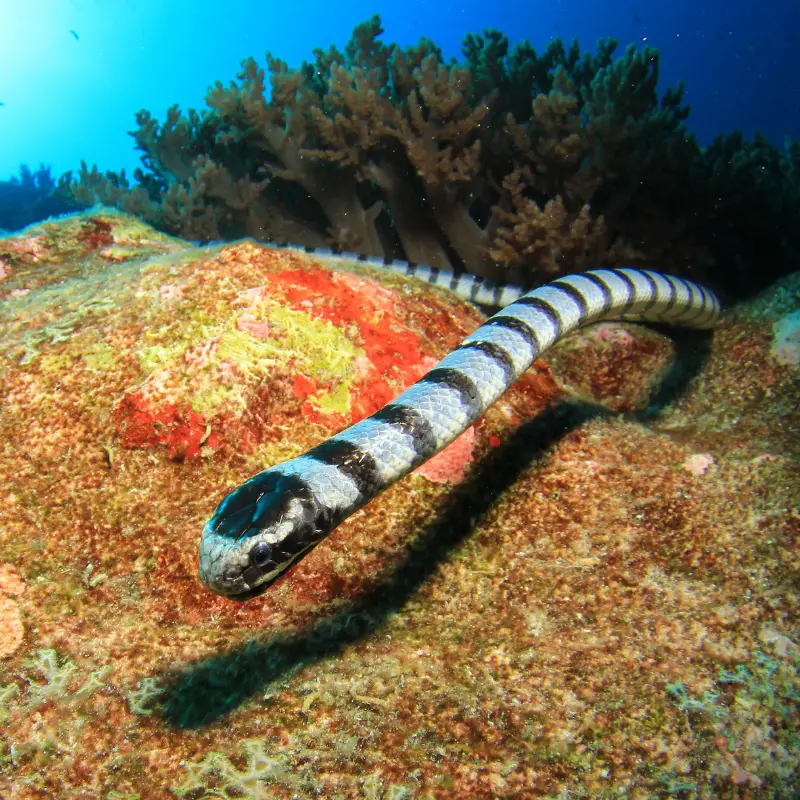
With the coral reef facing the threat of extinction, thanks to all the acids and other pollutants, the natural habitat of the Belcher sea snakes has come under severe threats. This phenomenon has compelled many of these snakes to find shelter in the reefs closer to the coastline, spiking up the human snake conflict significantly.
Behavioural Traits
Belcher’s sea snakes belong to a sub-family of actual sea snakes. That explains their flipper-like tail and high movement speed in the water. Even though these snakes can be dangerous, they are not that large physically. As we have mentioned, the adult Belcher’s sea snake usually grows from 50 centimetres to one meter in length. Even though the small mouth of the snake is suitable for their aquatic life, they are not made for biting humans.
Technically speaking, the only vulnerable places of human bodies where these snakes can bite comfortably are the ears and the tip of the fingers.
Fight Or Flight
These snakes are known for their gentle nature; unless they feel extremely threatened and disturbed. Belcher’s sea snakes prefer flight instead of fight. The fishermen are, generally, the most common victims of these snakes. Most of the time, snake bite incidents occur when the fishermen try to rescue the entangled snake from the fishing nets.
Reproduction
As these snakes live in the warm oceans, their mating is seawater supported. The male snakes start the mating process in the third year of their life, whereas the females start mating from their fourth or fifth year. The maturity of the snakes is not seasonal.
That means, unlike most sea snakes, the faint banded ones can mate anytime in the year. These snakes are ovoviviparous. That means the eggs stay inside the mother’s body until they hatch or at least about to hatch. The young snakes are born alive in the water, where they will spend the rest of their life.
Diet
Most of the sea snakes are not that fussy eaters, and they are entirely carnivorous. The faintly banded sea snakes are no different from the rest of the sea snakes in any way. Fishes are the primary food of these snakes.
The Belcher’s sea snakes live on the fish eggs, fish, crustaceans, and eels. These snakes use the coral reef to their advantage while hunting for their prey. They often locate suitable hunting places and ambush their prey when they move closer.
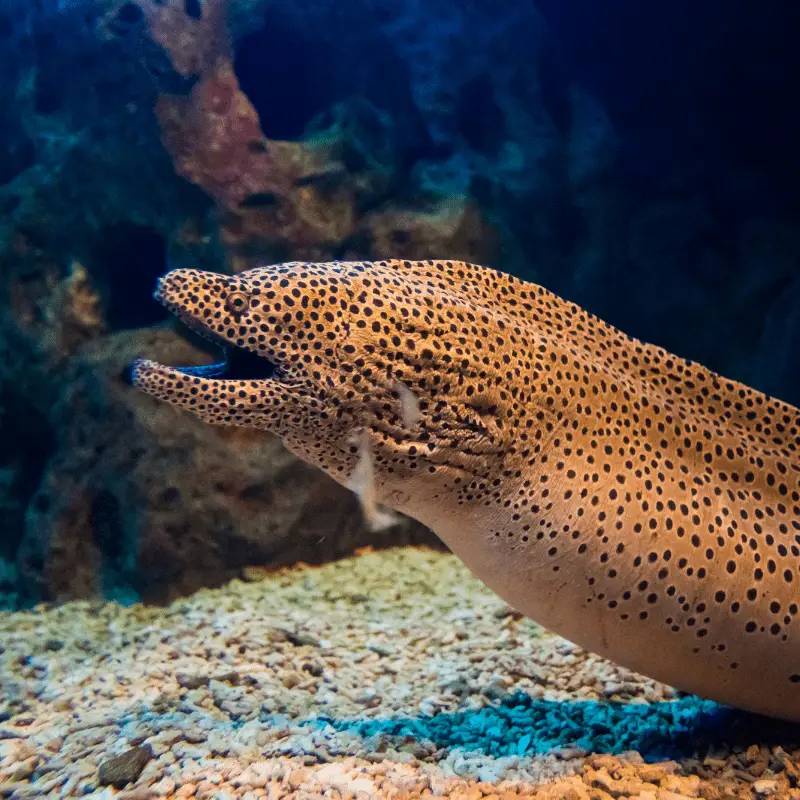
An eel 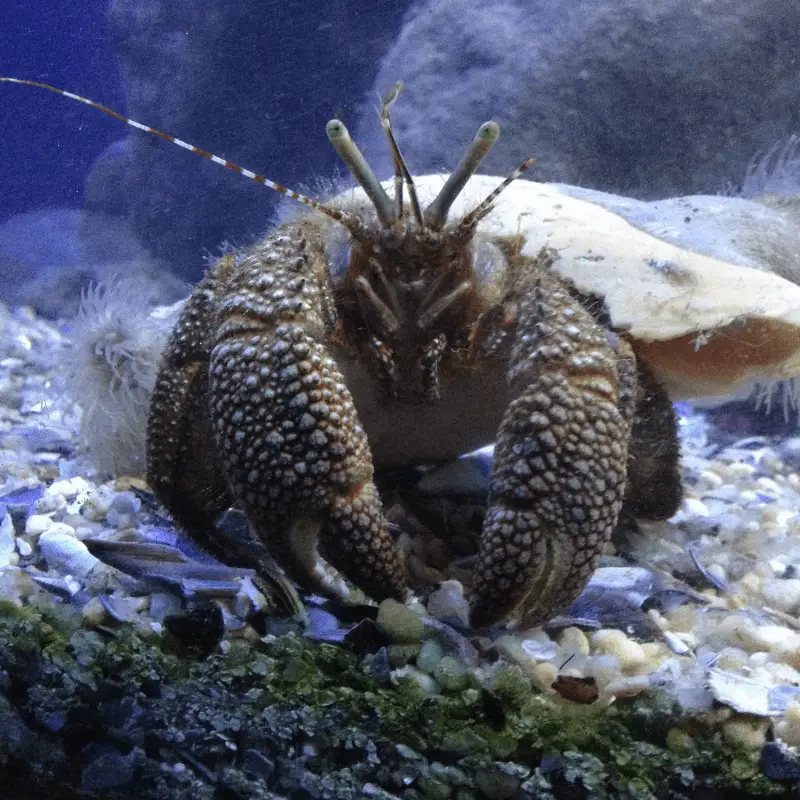
A Crustacean
Compared to the other sea creatures, the speed of the snakes are not that great, and they do not have much chance of catching fish in the open waters. The snakes will hide in the shadows and bide their time, and the fishes have little chance of escape.
The Predators of The Belcher’s Sea Snakes
Just as hiding helps these snakes to secure their food, it also saves them from the attack of the predators. The researchers have found out that the Grey-Headed Fish Eagles and the White Bellied Sea Eagles are the natural predators of the snakes.
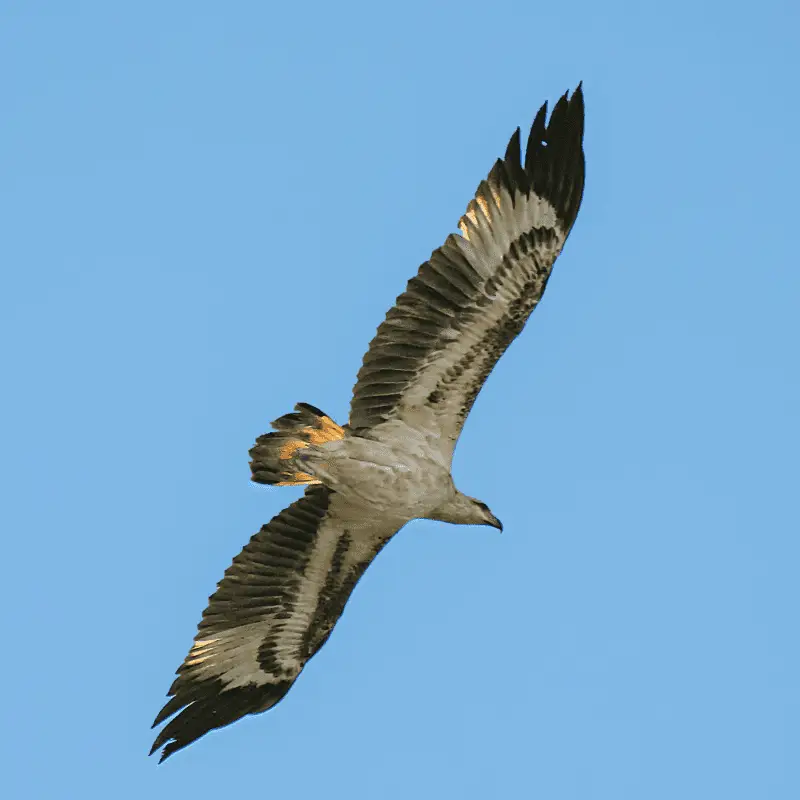
White Bellied Sea Eagle 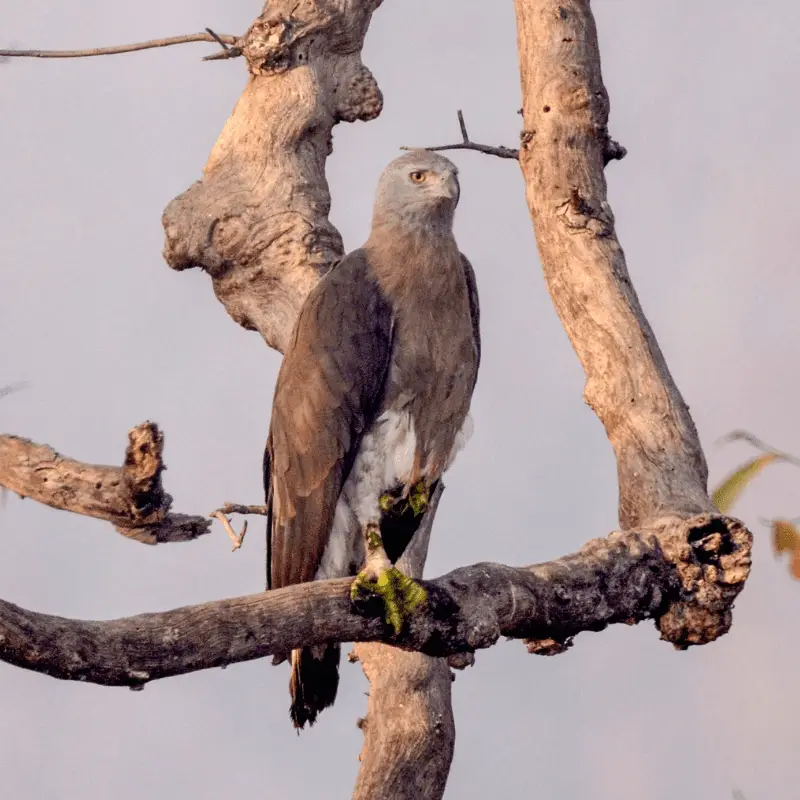
Grey-Headed Fish Eagle
Although information about other predators of the Belcher’s sea snake is scarce, researchers have noted that sharks also hunt these faint-banded sea snakes. Reports have shown that both the blacktip reef sharks and the great reef Sharks pursue these stripy snakes as their prey. Even some of the larger fishes, such as the Swordfish and giant eels, also hunt Belcher’s sea snake given the opportunity.
That does not mean all the threats of these striped snakes come from the deep blue waters. As we have already mentioned, the eagles also pose severe airborne threats to these snakes. However, most of these eagles like to feed on the injured or the young faint banded snakes instead of taking on the full-sized adults.
Do Sea Snakes Drink Sea Water?
No, snakes drink the rainwater from the surface of the sea.
It was previously believed that the sea snakes quench their thirst with the salty sea waters. The researchers thought that the snakes remove the excess salt through the specially designed sublingual glands. However, some recent researches suggest that most sea snakes take an innovative way to quench their thirst. The researchers have proved that the yellow-bellied sea snakes drink the rainwater from the surface of the sea.
During droughts, these snakes also suffer from dehydration, like most terrestrial creatures. While it has not been proven that the faint banded sea snakes showcase the same behaviour, it can be said that the chances of them exhibiting similar drinking behaviours are high.
How They Attack Their Prey
Faint banded sea snakes are hunters by nature. Surprisingly, these snakes are also very timid. The researchers consider the Belcher’s Sea Snakes as one of the gentlest animals in the world. Despite that, the hunting method of these snakes is not pleasant.
Like most sea snakes, the Belcher’s sea snakes also bite their prey first, injecting their potent venom. As the prey suffers from its futile and exceptional brief death throes, the Belcher’s snakes will hold on to them for dear life. They wait for the prey to quiet down while constantly pushing a bit more venom into the body of their prey each time.
Once the prey gives up the fight, the snake swallows it whole. These snakes always eat their prey headfirst in an attempt to avoid any unpleasant fins or spikes from obstructing its movements through their digestive system.
The Fangs and Bites of Belcher’s Snake
The bite of the Belcher’s sea snake is not that bad. However, the venom that it injects during the biting process is dangerous. Scientists have divided the fangs of the snakes into three different types. They are proteroglyphous, opisthoglyphous, and solenoglyphous. The Belcher’s sea snakes belong to the first group.
The fangs of the snakes in the proteroglyphous category are unique. Unlike the fangs of other snakes, they are fixed to the jaws of the snake. That means the fangs cannot be folded back. The fangs of the Belcher’s sea snake have a strong resemblance to needles. These fangs are short but extremely sharp.
These snakes cannot deliver a full dose of venom in the first bite. The faintly banded sea snakes deliver the venom through the progressive envenomation process. That is why the other venomous snakes, like cobra or rattlesnakes, release their victims, and the Belcher’s sea snakes prefer to hold onto them. It is also why very few of the Belcher’s sea snake bite victims sustain a total dose of venom.
When Does The Bencher’s Snake Attack?
As we have explained earlier, the Belchers snake is one of the gentlest creatures in the world. Given the opportunity, they will always choose to move away instead of fighting the adversary. Most of the interactions between the Belcher’s snakes and the humans happen underwater. As people tend to wear wet suits while swimming, they are safe from the bites of these snakes. The fangs of the Belcher’s sea snakes are so small that they cannot penetrate through the wetsuit of the swimmers. Also, as these snakes have small mouths, they cannot bite anything more significant than human fingers.
Most of the time, the fishermen get envenomated by the Belcher’s sea snakes when they try to free the entangled snakes from the fishing nets. These snake bite incidents are not exclusive to the Belcher’s sea snakes as well.
The venom of the Belcher’s sea snakes contains a neurotoxin, which disrupts the chemical signals that travel between the brain and our body. The toxin attacks the nervous system. The effect of the poison becomes evident within the first few minutes of the snake bite. The initial symptoms of a Belcher’s Snake Bites are As follows.
Human Belcher’s sea snake bite symptoms
- Drooping eyelids
- Blurred vision
- Difficulty in moving legs.
- Aching joints
- Sore muscles
- Nausea
- Difficulty in swallowing and speaking
- Prolific saliva production
If the envenomation process gets completed, these symptoms quickly become worse. The bite victim starts showing more severe symptoms, like difficulty in breathing or irregular heartbeats.
The only good thing is that the Belcher’s sea snakes cannot deliver a total dose of toxins in their first bite. That is the reason why most of the victims of the Belcher’s Sea snake bites survive. Even if the snake can deliver a total dose of venom, the victim should make a full recovery if treated promptly with the required antivenom.
Are Belcher’s Sea Snakes Classed As One Of The Most Venomous Snakes?
Even a couple of years ago, the answer to this question would have been positive. However, in light of some new evidence, it seems that the previous claim was not correct. Even though you would not want to get bitten by the Belcher’s Sea Snake, its venom would not kill you as quickly as such snakes like the Inland Taipan.

